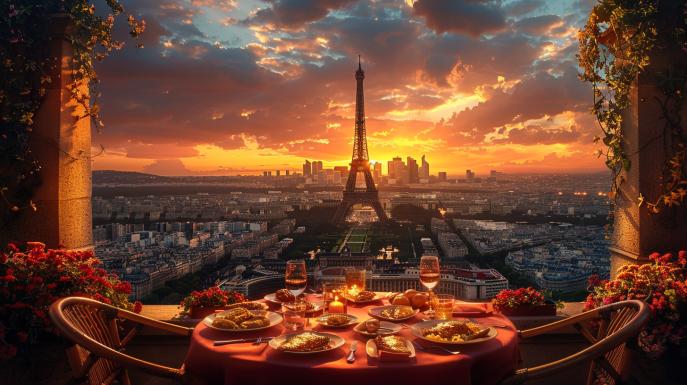Have you ever imagined traveling the globe tasting the most extraordinary aspects of each culture? In “Guided Gastronomic Experiences Around the Globe”, we embark on a journey to discover why culinary experiences become unforgettable milestones in our adventures around the world. Reflect with us: what if each flavor was a story and each aroma was an eternal memory? Join us in discovering unique flavors that define societies and hold ancient secrets. Discover dishes that not only feed the body, but also the traveling soul.
Why are unique culinary experiences so memorable when traveling?
Traveling is an invitation to a sensory celebration, and few things touch our senses as strikingly as the unforgettable gastronomic experiences around the world. Why do they affect us so deeply?
Our ability to remember a moment is greatly enhanced through flavors and aromas. It is a science and an art, where the importance of the senses in remembering travel is undeniable. Unique flavor discoveries they are engraved in memory not just as a sequence of ingredients, but as an emotional narrative.
Consider Kaiseki in Japan: It's not just a meal — it's a seasonal odyssey that honors aesthetics and honors ancient customs. Visualize the presentation of each dish, the balance, the meticulous details. Yes, you can spend from $100 to more than $400 per person, but it is a gustatory meditation, a ritual in which each mouthful tells a story.
In Italy, in Modena, the creation of traditional balsamic vinegar is a testament to time, with its careful aging. A small bottle can cost more than $200. Why so much? Each drop encapsulates decades of passion and craftsmanship — a liquid heritage that connects the palate straight to the heart of Italian culture.
Meanwhile, on the vibrant streets of Mumbai or Delhi, the experience is contrasting, but no less impactful. For less than $1, you participate in an informal festival of vibrant flavors. However, there are prudent precautions to take regarding hygiene, a reminder of the importance of respecting local practices.
And then we have France, with Bordeaux representing a pantheon for wine lovers. Just like a good book, a good wine tells a story, with bottles costing from $50 to thousands, and tastings ranging from $10 to $100+.
Gastronomic experiences around the world they provide an authentic connection with the place: they connect us with its culture, its people and its stories, as we navigate the globe guided by our taste buds.
What are the best typical dish tasting experiences that you can't miss?
Have you ever imagined yourself tasting dishes that define a culture, on a sensorial journey that transcends the palate? A tasting of typical dishes is a window into the soul of a people, an invitation to understand their history, traditions and geography.
In Japan, the ritual known as Kaiseki exemplifies the meeting between art and seasonality on the plate. This experience can range from $100 to more than $400 per person, where each dish is a celebration of the season, presented in a careful and ceremonial manner. When tasting a Kaiseki, it's not just the flavor that delights; it is the sublimity of the presentation and the reverence for the ingredients.
In Modena, Italy, the Traditional Balsamic Vinegar emerges from a centuries-old process. With a maturation that can last from 12 to 25 years, little by little, the essence of this condiment gains complexity and, therefore, a small bottle can cost more than $200. The flavour? A symphony of sweet and sour, a centuries-old process of perfection.
Meanwhile, the vibrant street food scene in India, especially in Mumbai, offers a diverse and affordable experience, with dishes under $1. Here, the challenge is adventure, as you have to navigate concerns about hygiene to enjoy the most authentic flavor of the streets.
Finally, remembering authentic dishes means bringing with you a piece of the place you visited – they are tasty memories that tell stories. And no matter the destination, from luxurious offerings to economical options, tastings of typical dishes are guaranteed passports to a transformative culinary adventure. After all, who could forget the day when a dish, more than just food, told a story?
Where to find the best unmissable gastronomic itineraries around the world?
Around the globe, unmissable gastronomic itineraries sharpen our senses and feed the soul with unique cultural experiences. Imagine tasting the most exquisite wines directly at the source. Bordeaux is not just a destination: it is a toast to the best wines in France, where you can taste labels ranging from $50 to values that defy the limits of the imaginable, in tastings that start at around $10.
How about starting the day with the authentic flavors of Japan? Tsukiji, a market that is a true institution in Tokyo, offers A morning of fresh flavors, where a breakfast with sushi, which costs between $30 and $50, expresses the quality of the tuna auctioned there.
We cannot forget the movement that reinvented Scandinavian cuisine. In Copenhagen, the name The philosophy of New Nordic Cuisine resonates, in menus that cost around $350, bringing regional ingredients to the world stage.
In Italy, more precisely in Modena, traditional balsamic vinegar is a legacy, where some bottles with decades of aging exceed the value of $200. In contrast, Marrakesh seduces with full meals for just $5, in the effervescent Jemaa el-Fnaa.
International food festivals complement this sensory journey, celebrating everything from Indian street food, with delicacies below $1, to the exquisite kaiseki in Japan, marking the meeting of art and seasonality in dishes that can range from $100 to more than $400 per person .
Gastronomy, in this way, becomes a fabric that stitches the tapestry of travel memories, balancing authenticity, price and health care, as it reflects a universe of culinary possibilities across and around the planet.
How can the search for starred restaurants and renowned chefs transform your travel experience?
Traveling is an opportunity to explore new horizons and gastronomy is a portal that invites us to delve into the culture and history of a destination. Have you ever wondered how selecting starred restaurants around the world can enrich your journey? By choosing an establishment with a Michelin star, or a restaurant that bears the name of an internationally renowned chef, you not only taste exceptional dishes, but also experience a culinary narrative that tells the history of the place, reflects refined techniques and expresses a gastronomic tradition .
Renowned chefs and their kitchens are masters at creating memorable experiences that go beyond taste. In places like Central Restaurante in Lima, you can experience the soul of Peru in every dish, where the fusion of autochthonous flavors with modern techniques reveals a new dimension of fusion cuisine.
Have you ever imagined the thrill of enjoying dishes that recount a historical scene in places that have stood the test of time? This is possible by enjoying dishes in environments that are, in themselves, living monuments of history, providing a fascinating journey of eating in historic places.
Furthermore, by being part of the social tradition surrounding the preparation and consumption of food, such as when “walking” through the streets of Spain, you participate in a ritual that is the essence of local culture. And why not explore this practice through tapas that shape social encounters?
By opting for this selective culinary search, you are not only satisfying your palate, but also appropriating ancient knowledge, connecting emotionally and intellectually with your trip, and transforming a simple meal into an imperishable memory.
On this journey through the universe of culinary experiences when traveling, we revisit the way in which unique flavors and gastronomic stories intertwine with the memory of our discoveries around the world. From the art of Japanese kaiseki to the vibrancy of Mumbai's streets, each dish is a gateway to understanding local culture. We also explore itineraries that take us by taste to festivals and markets, without forgetting the renowned chefs who transform meals into stellar moments of the trip. In essence, it is the cuisine that often defines the spirit of a place, leaving memories that last long after you return home. May the flavor of each journey continue to be a challenge as appetizing as it is enriching.
FAQ
Common questions
1. Why can gastronomic experiences make a trip unforgettable?
Culinary experiences have the power to make a trip unforgettable because they awaken the senses and create an emotional connection with the place. Through flavors and aromas, a meal becomes an affective memory, which goes far beyond the food: it becomes a narrative of the culture, traditions and stories of the place.
2. How much can I expect to spend on an authentic tasting experience in countries like Japan and Italy?
When participating in authentic tasting experiences, costs can vary significantly depending on the location. In Japan, for example, a Kaiseki can cost from $100 to more than $400 per person. In Italy, a bottle of Traditional Balsamic Vinegar of Modena can exceed $200, due to its long aging process and sensory complexity.
3. Where can I find unmissable culinary experiences around the world?
Unmissable culinary experiences can be found in destinations such as Bordeaux, France, with fine wine tastings, or Tsukiji market, in Tokyo, where a high-quality sushi breakfast is a unique sensory experience. There are also options like Noma in Copenhagen, highlighting New Nordic Cuisine, and vibrant street food in Marrakesh for just $5, providing a rich tapestry of travel memories.
4. How can the selection of starred restaurants or renowned chefs enrich my travel experience?
Selecting starred restaurants or renowned chefs can significantly enrich your travel experience by offering not only a tasting of exceptional dishes, but a deep immersion in local culture and history. This allows you to experience a culinary narrative that reflects refined techniques and a rich gastronomic tradition, transforming a simple meal into a memorable and educational experience.







